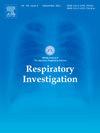Nutritional assessments as predictors of prognosis after long-term oxygen therapy in patients with idiopathic pulmonary fibrosis
IF 2
Q2 RESPIRATORY SYSTEM
引用次数: 0
Abstract
Background
Idiopathic pulmonary fibrosis (IPF), a chronic and progressive interstitial lung disease, frequently leads to chronic respiratory failure, necessitating long-term oxygen therapy (LTOT). Although the prognosis of patients with IPF receiving LTOT is generally poor, limited data are available on clinical factors associated with post-LTOT survival. This study aimed to investigate whether baseline nutritional status at the time of initiation of LTOT is associated with survival outcomes in patients with IPF.
Methods
We retrospectively reviewed 55 patients with IPF and chronic respiratory failure who initiated LTOT. Patients were stratified into two groups based on 1-year survival following LTOT initiation: long-term survivors (≥1 year) and short-term survivors (<1 year). Nutritional status at baseline was assessed using the Geriatric Nutritional Risk Index (GNRI), Prognostic Nutritional Index (PNI), body mass index (BMI), and fat-free mass index (FFMI).
Results
Significant differences were identified between the two groups in BMI, GNRI scores, and the proportion of patients receiving antifibrotic agents. In multivariable analyses adjusted for age, sex and the use of antifibrotic agents, both a GNRI score <92 and a low FFMI were independently associated with increased mortality risk (p = 0.033 and p = 0.007, respectively). Kaplan–Meier analysis demonstrated significantly poorer 1-year survival in patients with GNRI <92 and low FFMI (p = 0.037 and p = 0.006, respectively).
Conclusion
GNRI and FFMI independently predicted 1-year survival in IPF patients on LTOT. These findings underscore the importance of nutritional evaluation at LTOT initiation and suggest that low GNRI and FFMI warrant closer monitoring and targeted nutritional interventions.
营养评估作为特发性肺纤维化患者长期氧疗后预后的预测因素
背景:特发性肺纤维化(IPF)是一种慢性进行性间质性肺疾病,常导致慢性呼吸衰竭,需要长期氧疗(LTOT)。虽然IPF患者接受LTOT的预后通常较差,但与LTOT后生存相关的临床因素的数据有限。本研究旨在探讨开始LTOT时的基线营养状况是否与IPF患者的生存结果相关。方法回顾性分析55例IPF合并慢性呼吸衰竭患者行LTOT治疗。根据LTOT开始后的1年生存率将患者分为两组:长期幸存者(≥1年)和短期幸存者(<;1年)。采用老年营养风险指数(GNRI)、预后营养指数(PNI)、体重指数(BMI)和无脂体重指数(FFMI)评估基线时的营养状况。结果两组在BMI、GNRI评分和接受抗纤维化药物治疗的患者比例方面存在显著差异。在调整了年龄、性别和抗纤维化药物使用的多变量分析中,GNRI评分为92分和低FFMI均与死亡风险增加独立相关(分别为p = 0.033和p = 0.007)。Kaplan-Meier分析显示,GNRI <;92和FFMI较低的患者1年生存率明显较低(p = 0.037和p = 0.006)。结论nri和FFMI独立预测IPF患者LTOT 1年生存率。这些发现强调了在LTOT开始时营养评估的重要性,并表明低GNRI和FFMI需要更密切的监测和有针对性的营养干预。
本文章由计算机程序翻译,如有差异,请以英文原文为准。
求助全文
约1分钟内获得全文
求助全文

 求助内容:
求助内容: 应助结果提醒方式:
应助结果提醒方式:


